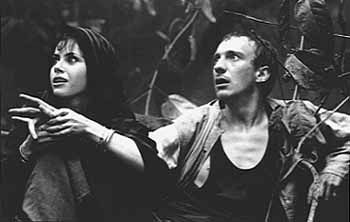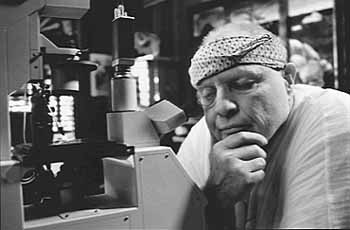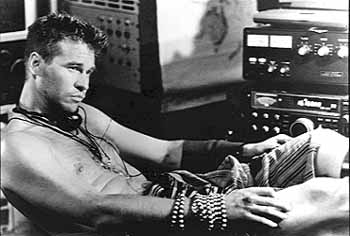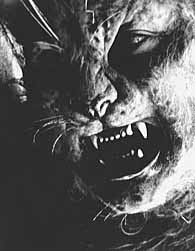















 |

|
With Brando swathed in white gauze, his face painted white and colorful scarves tied around his head, the movie lurches from one scene to the next, precariously perched on the edge of camp. And Kilmer isn't far behind Brando. By the movie's end, Kilmer himself is imitating Brando's lunacy, wrapping himself in white robes and mumbling his best Brando imitations, while the creatures bump and grind at his feet in what looks like an industrial discotheque.
|

Fairuza Balk (Aissa) and David Thewlis (Edward Douglas) flee through the jungle. (©1996 New Line Cinema) |

As the third screen version of H.G. Wells' classic tale of horror, The Island of Dr. Moreau tells the story of Edward Douglas (David Thewlis), shipwrecked at sea, who is picked up by a ship from Dr. Moreau's island, helmed by Moreau's right hand man, Montgomery (Val Kilmer). Located somewhere in the Java Sea, Moreau's island is his own paradise, apart from intruding eyes, who might be alarmed at the hideous experiments he conducts on animals. Douglas quickly learns what Moreau is up to, but he finds himself trapped on the island--with the forest surrounding Moreau's home teeming with Moreau's hybrid experiments, twisted masses of flesh, half-man, half-animal.
|

Marlon Brando in a calmer moment as Dr. Moreau. (©1996 New Line Cinema)
|

The story itself is one of the great horror stories of all time. And the first screen version, Island of Lost Souls, filmed in 1932 with Charles Laughton as Moreau and Richard Arlen as Douglas, is an astounding work of cinema. Filmed in an expressionistic style by director Erle C. Kenton, with dramatic shadows running up walls as if darkness itself is evil, Island of Lost Souls is a marvel of storytelling, pulling back layer from layer from the mystery to reveal the horrific truth of Dr. Moreau's experiments and providing plenty of suspense along the way.
But what can The Island of Dr. Moreau give us that the original couldn't? Well, the remake, thanks to the work of Stan Winston's special effects crew, provides an even more horrific vision of the bloated, pink masses of flesh that speak English but snort and paw the ground like animals. For all the accomplishments of the 1932 Paramount Production, it can't touch the remake for providing the same sense of shuddering, unspeakable horror.
|

Val Kilmer taking a breather. (©1996 New Line Cinema)
|

However, in terms of storytelling, the remake is an absolute mess. Brando's performance, which should be enough to convince any court in the world that he is certifiably insane, needed to provide this movie with a strong core, but his whimsical touches, such as dressing in matching outfits with his favorite animal-creature, a half-sloth creature with a bulbous butt and a slippery little bloated pink tail, send the movie skittering over the edge of reason and into a head shaking, "what the hell could they have been thinking" category. At one point Brando and the sloth-man creature play a piano duet, with the sloth-man playing a tiny piano on top of Brando's baby grand. When Brando first appears on screen, he's wrapped in white cloth, his face is painted white, he's shrouded by mosquito netting, and carved shell necklaces hang from his neck: he looks like a Rose Bowl queen as his servants carry him on a cart around the island. Occasionally, he roams his house, eating milk and cookies, occasionally peering into a microscope while shaking his head and sighing. With pursed lips and false teeth, he lectures Thewlis, at times wearing a huge metallic hat that he pours ice water into to cool his head. In one of the funniest lines in the movies, his daughter (actually a half-woman, half-animal creature) says mournfully, "I want to be like you." If only she knew . . .
Kilmer isn't far behind Brando in the overacting category. He carries the early scenes well, even injecting some funny asides, such as when he gives Douglas medication and Douglas asks if he's a doctor: "Well, more like a veterinarian." But as the movie moves into its final half hour, Kilmer begins his Brando imitations, dressing like Moreau and speaking with the same tight-jawed mumble. Thewlis emerges as the only hope for sanity among the lead actors, and as always (his performance in Naked is stunning) he strikes a compelling image, but he's hardly a charismatic actor, hardly someone you can really cheer for.
As the movie careens out of control, Brando and Kilmer share turns driving the movie headlong over a cliff, with Frankenheimer apparently bound and gagged and locked in the trunk.
|
|


















